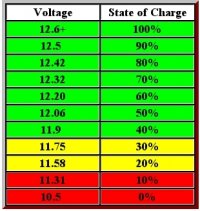ThomasHJ
Top Poster
Lifetime VIP Member
I have always wondered what the minium voltage level is for the (AGM) leisure batteries. I never seem to find a straight answer, mentioning a certain voltage number. Neither on websites or on the forums here. Or when I do, it differs from other sources that mention a different number. The answer to the question doesn't seem straightforward, because the voltage of a battery should be measured without load, and without it being charged and after (at least) 12 hours in rest. Which, when using the van, isn't a realistic option.
Today I found the following article online, which explains in depth the way AGM batteries work and I found it very enlightening. Perhaps it is of use to others here. For some it may not be new, for some it might be useful.
Still wondering though, what is the lower limit you use for the voltage? In other words, at what V (as shown on the control panel and not being on EHU) do you feel you can no longer use the van's electricty and really need to either drive the van or get on EHU?
Today I found the following article online, which explains in depth the way AGM batteries work and I found it very enlightening. Perhaps it is of use to others here. For some it may not be new, for some it might be useful.
Still wondering though, what is the lower limit you use for the voltage? In other words, at what V (as shown on the control panel and not being on EHU) do you feel you can no longer use the van's electricty and really need to either drive the van or get on EHU?















